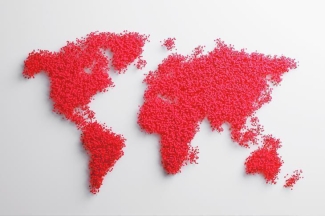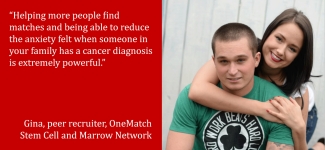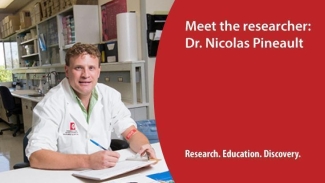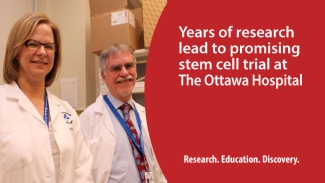Understanding who is "most wanted" when it comes to stem cell and cord blood donors
Wednesday, May 18, 2016 Lisa Willemse
By Lisa Willemse
There’s nothing better than a success story. A touching reunion between a cancer survivor and their stem cell donor. But more often we hear in the news about the desperate search for a match, a plea from an individual or family who are unable to find a matching stem cell donor within their circle and are in desperate need for someone to step forward.
Often you’ll hear pleas calling members of a specific ethnicity to come forward. You might also notice blanket calls for more young men to step up and join a stem cell registry, such as the recent “Real men” campaign in the UK.
Blood stem cell transplants are used to treat over 80 diseases and disorders, including many cancers and inherited immune system and metabolic disorders.
These specific calls are not due to chance: although the diversity of donors has broadened in Canada, there is still a need for more, particularly among some ethnic groups with low representation (i.e. First Nations, Métis, Inuit and African-American). Ideally, those personal plea stories will become a thing of the past, because a matched donor will be easily found in a stem cell registry or bank.
On that front, Canada is doing a very good job. Dr. David Allan, medical director for Canadian Blood Services’ Cord Blood Bank and OneMatch Stem Cell and Marrow Network, reports that more than 1,000 units of cord blood are now available in the public Cord Blood Bank. It officially launched less than a year ago and just over half the units collected represent ethnicities other than Caucasian. A similar diversity profile exists in the OneMatch registry, where more than 350,000 volunteers have come forward to register as possible donors.
The best match for any patient is quite often a sibling. But for a variety of reasons, it’s not always a sure thing, and when it’s not, an unrelated donor is required. Currently, about 600 transplants using stem cells from an unrelated donor take place in Canada each year. While some come from the Canadian registry, many are found in one of several larger international registries.

But for some patients, the transplant doesn’t happen at all. It’s not that easy to tease out the reasons behind this.
“There are multiple possibilities,” says Dr. Allan. “One is there is no suitable donor available. There are also situations in which the patient became too unwell, or the disease was not controlled adequately.” Any one or a combination could be at play, and the one we have the best chance of controlling is ensuring a matched stem cell transplant is available.
Donors and patients are matched according to the compatibility of inherited genetic markers called human leukocyte antigens (HLA). These antigens are inherited from your parents. Up to 12 antigens are considered important in the matching process. The best transplant outcome happens when a patient and donor’s HLA typing closely match.
When it comes to matching, family matters
They say blood is thicker than water, and when it comes to the properties of stem cells that exist in bone marrow (where blood cells are made), circulating blood and umbilical cord blood, this is certainly true. Attached to the surface of those stem cells (and most other cells in your body) are particular proteins – or markers – that are part of the genetic material handed down from parent to child.
These markers, known as human leukocyte antigens, or HLA for short, play a crucial role in the body’s immune response. Cells with your unique HLA profile are considered safe by your immune system, and those with a foreign HLA will be seen as invasive and therefore attacked by your immune cells. It is this immune function that causes some patients to reject transplanted tissues or organs, a situation that can put their lives at risk.
Over at Dalhousie University, it’s Dr. Robert Liwski’s job as medical director of Canadian Blood Services’ HLA typing laboratory to understand the nuances of HLA, to conduct and probe the latest research in order to ensure the highest degree of safety for the patients in Canada who are candidates for a transplant each year.
There are four main classes of HLA (A, B, C and DR) considered important for stem cell transplant purposes. Each is comprised of a sub-set of molecules (as many as 10,000 different molecules in total) with specific immune function. To give an idea of this level of specificity, one molecule, HLA-B53, has a particular affinity towards identifying malarial pathogens – if you get bitten by a malarial mosquito, you want this molecule in your HLA arsenal.
In order to avoid an immune attack against the transplanted stem cells, reduce complications that extend hospital stays, the patient’s body needs to recognize and tolerate the donor HLA markers as its own. There are eight different markers to consider (you get four, one set of A, B, C and DR from each parent, times two parents) when choosing a stem cell donor. You’ll rarely be more than a 50 per cent match to either parent, but, says Dr. Liwski, “roughly 25-30 per cent of people will have an HLA identical sibling. The other 70 or so per cent need to either go for an unrelated donor search through registries or consider a cord blood donation.”
Because the immune cells in cord blood are less mature they are not as potent and can therefore tolerate more of a mismatch. But cord blood as a source of transplantable stem cells presents its own problems, chief among which is the relatively small number of viable stem cells in each unit, meaning two units are often required for a single transplant, which increases demand and cost.
Finding a match is also a “neighbourhood” affair
Because HLA is an inherited component of immune response, it also adopts an evolutionary function.
As Dr. Liwski explains, “HLA molecules appear to have evolved to recognize the signatures of infections that are common in the area where you live. So, for example, among the populations that exist in Asia or Africa or Europe there are certain infections that are prevalent in those regions, and for each population, their HLA molecules have evolved to recognize the particular pathogens.”
Remember that HLA-B53 anti-malarial molecule? Turns out it shows up more frequently among some populations than others.
“B53 is very common in people of African origin, present in more than 15 per cent, but it’s rare in Caucasians at only about 0.3 per cent, so this HLA molecule may have simply evolved to try to defend these populations against a pathogen that is prevalent there,” says Dr. Liwski.

Global differences in disease prevalence and HLA evolution help to explain why it’s easier to find an HLA match within your own ethnic group – and why it’s so important for people of all ethnic backgrounds to be adequately represented in the stem cell registry and cord blood banks.
Young males wanted
HLA matching is thorny enough with its evolutionary and hereditary considerations. But there are biological ones as well: it turns out that young males make excellent candidates for stem cell donation. The reasons for this are quite simple.
First, younger, healthy adults (no matter what their gender) tend to have a more robust supply of stem cells available, which means a single donation of peripheral blood or bone marrow can yield more cells for transplant.
Second, pregnancy can throw a bit of a monkey wrench into the matching process. A woman who has been pregnant has been exposed to HLA that is not hers (the baby carries 50 per cent of the father’s genetic code, including HLA), and her immune system has responded with effector cells and antibodies that she now carries in her blood. This higher sensitivity in a previously pregnant donor increases the likelihood of graft vs host disease, a potentially serious complication where the donor immune cells attack the cells, tissues and organs of the recipient.

“It’s not that females are undesired in any way,” Dr. Allan is quick to point out. “What’s most important is that we have committed donors.”
“When donors register, we really count on their willingness to donate, even if it’s some years in the future. Canada’s standing on the international stage is quite admirable, in terms of commitment, both from the males and especially from the females – females tend to remain very committed for very long periods of time. So the contribution from our female registrants is not insignificant and is highly valued.”
What does the future hold?
Getting to that place where more patients in need of a stem cell transplant can find a matched donor may not be that far away. One of the more promising areas of recent research involves a new protocol that is opening up the possibility for greater numbers of transplants from related donors, thereby reducing the demand on the stem cell registries and public cord blood banks.
Called a haplo-identical transplant, this protocol allows for a 50 per cent HLA match to be used (far below today’s clinical standard), in conjunction with a drug that dampens the immune response. Using this protocol means that a parent or child, or a less-than-perfectly-matched sibling can become a stem cell donor. In the past five years, a much greater number of haplo-identical transplants have taken place, primarily in Europe and the US, and early indications are positive.
But both Dr. Allan and Dr. Liwski cautioned that it’s too early to be overly optimistic, as the long-term outcomes for patients is not yet known, and much research still needs to be done to track patient response based on the condition treated. All of this is currently taking place.
Even with the possibility of haplo-identical transplants relieving a bit of the burden, Dr. Allan doesn’t see it reducing the need for new donors in the OneMatch Stem Cell and Marrow Network registry or the Cord Blood Bank. “Because of shrinking family sizes over the recent decades and also because we’re doing transplants in older individuals who may not have a sibling that is healthy enough – or even alive in some cases – to donate cells, so we’re having to rely more and more on unrelated donors and cord blood donors or alternative sources of cells.”
“We still very much need and appreciate our stem cell donors,” he says.
Find out more about the OneMatch Stem Cell and Marrow Network registry and Canadian Blood Services' Cord Blood Bank.
What is a hematopoietic stem cell? Narrated by Dr. Connie Eaves from Stem Cell Network on Vimeo.
Canadian Blood Services – Driving world-class innovation
Through discovery, development and applied research, Canadian Blood Services drives world-class innovation in blood transfusion, cellular therapy and transplantation—bringing clarity and insight to an increasingly complex healthcare future. Our dedicated research team and extended network of partners engage in exploratory and applied research to create new knowledge, inform and enhance best practices, contribute to the development of new services and technologies, and build capacity through training and collaboration.
About the Author
Lisa Willemse is a communications professional with 18 years’ experience working in the technology, child development and health research fields, and is currently a Senior Communications Advisor with the Ontario Institute for Regenerative Medicine. With a background in fine art, communications and journalism, Lisa continues to moonlight as a writer, photographer and editor, contributing to a range of Canadian and US-based publications. In 2014, she was invited alumni-in-residence for the acclaimed Science Communications program at the Banff Centre. Follow her on Twitter and Medium @WillemseLA
The opinions reflected in this post are those of the author and do not necessarily reflect the opinions of Canadian Blood Services nor do they reflect the views of Health Canada or any other funding agency.
Related blog posts
Dr. Pineault and his team are working on a cellular therapy to improve engraftment (the process through which new blood-forming cells start to develop in the patient) following cord blood stem cell transplantation.
Led by The Ottawa Hospital, a groundbreaking trial called Cellular Immunotherapy for Septic Shock is testing the idea that mesenchymal stem cells may be able to help control the body’s immune system to reduce injury and promote healing, while improving its ability to fight infection.

